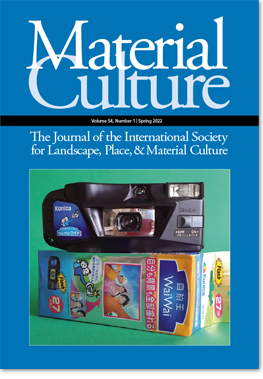Material Culture Culture is printed two times a year for members of PAS:APAL. It is abstracted and indexed in: JSTOR, ProQuest, History and Life, Historical Abstracts, GeoAbstracts, and the MLA International Bibliography. You may download a PDF of the table of contents of the current issue here. The Spring 2022 issue of Material Culture includes:
 The Analog Heritage of “Selfies”
The Analog Heritage of “Selfies”
Dirk HR Spennemann, Institute for Land, Water, and Society, Charles Sturt University, Australia
Abstract: “Selfies,” where people take self-portraits with their mobile phones held at arm’s length, have become one of the defining features of the millennial generation. Given their ubiquity, which is intrinsically linked with social networking sites, it tends to be forgotten that the selfie originated in the age of film cameras and found its first wave popularity with the arrival of disposable cameras in the 1990s. This paper describes and discusses the Konica Waiwai, the first and only disposable film camera specifically designed for selfie photography. First produced in 2002, it was soon supplanted by the development of cell phones with built-in cameras suitable for taking “selfies.”
Living in a Material (Covid-19) World: Covid-19, Materialities, and Quotidian Geographies in the Philippines
Mylene T. De Guzman, Joseph Palis, Emmanuel B. Garcia, Department of Geography, University of the Philippines-Diliman
Abstract: How is COVID-19 experienced differently across regions, cultures, and scales? Cognizant of the multiplicities in the experience of the pandemic worldwide, our paper focuses on the intersection of epidemiology, governance, structural violence, and cultural response to COVID-19 in the Philippines. Equal attention is devoted to various pandemic-related materialities (facemasks and face shields) and non-pharmaceutical interventions which show a mismatch in health protocols among the health-seeking behavior of the population. For this paper, we define material culture as the various materialities engendered by the global response to COVID-19. Our paper discusses unequal geographies where state-imposed directives that demand strict compliance towards COVID-19 highlight class inequalities, access, and how health and sickness are differently viewed and practiced by Filipinos. Finally, the storying of our individual pandemic encounters and experiences from everyday life hope to provide ground-truthing as we reflect on our embodied ecologies with the virus.
Boosterism and Architecture: The Origins of Foeller, Schober, and Stephenson’s Gasoline Station Designs
Keith A. Sculle, retired, Illinois Department of Conservation
Abstract: Architectural reformers and material culture analysts are increasingly investigating the influences which affect structural design (e.g., Lang et al. 1974; Glassie 1975). A wide variety of building types have been analyzed with varying success. Among the most studied designs of popular architecture has been the gasoline station whose design has been attributed chiefly to impersonal sforces including form, image, and technology (Jakle 1978; Vieyra 1979; Lohof 1974). This study examines one of the two popular sources of early gasoline station design, the independent architect who designed a few stations for a few local retailers, as contrasted with the corporate architect who designed for a regional or national market. The architectural firm of Foeller, Schober, and Stephenson is noteworthy because it helped set a pattern in gasoline station design when the question of the appropriate style was undecided. The firm’s solution, its application of the design, and the implications of the decision will be analyzed to extend our knowledge of the interrelationships between the architect and societal forces in the evolution of a design.
